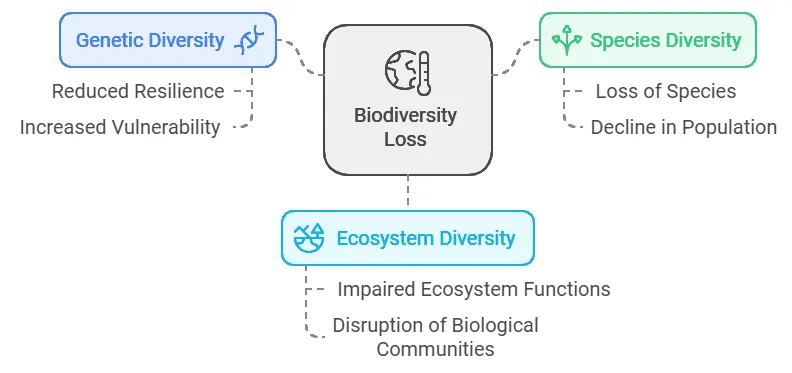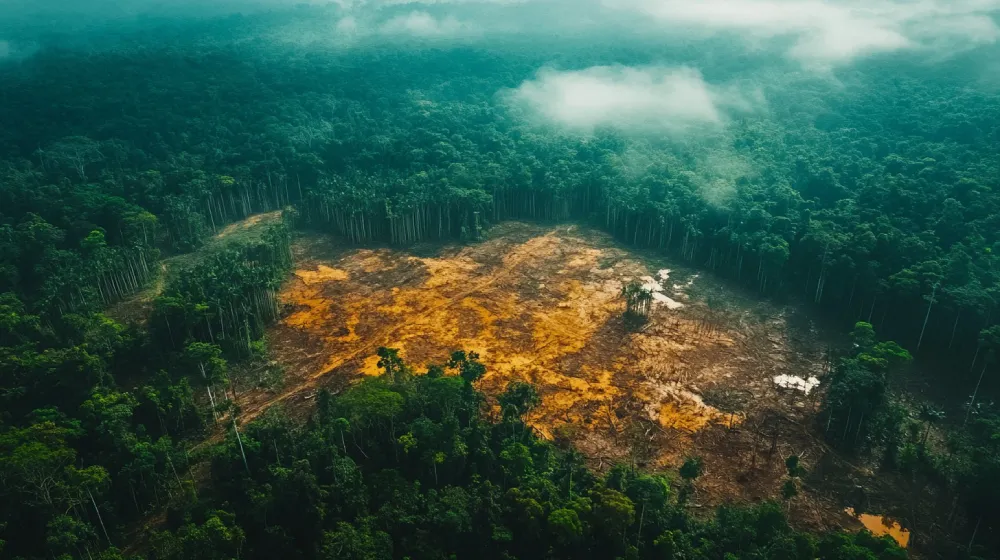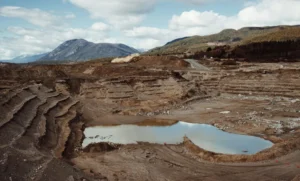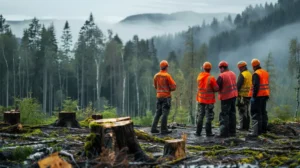Our Earth is full of different kinds of living things, from very small bugs to very large animals. It’s important to have variety of life on Earth because it keeps the world healthy and also helps humans.
But this web of life is in trouble right now. Habitat destruction and climate change are the biggest cause of biodiversity loss. We are losing lots of different kinds of plants and animals and it might not seem much but it’s a very serious issue.
In this blog, we’ll talk about how serious the problem of losing biodiversity is and how it could be as big deal as climate change for us.
What is Biodiversity Loss?

Biodiversity loss refers to the decline in the variety of life on Earth. This decline can occur at various levels, from genetic diversity within species to the loss of entire ecosystems.
When the number, genetic diversity, and species diversity in an area decline, it’s called biodiversity loss. This can also affect the biological communities in that area. Biodiversity loss damages how ecosystems function, which can have serious consequences.
The Impact of Biodiversity Loss
Biodiversity loss means losing different kinds of animals and plants, which is bad for humans. Extinctions happened before, but now they’re happening super fast. The extinction rate today is about 1,000 times faster than it should be.
When biodiversity is lost, it messes up important things nature does for us, such as purification of air and water, nutrient cycling, soil formation, pollination, and climate regulation. It also affects stuff such as preventing floods and keeping diseases from spreading.
Root Causes of Biodiversity Loss
Lots of things make animals and plants disappear, but the main reason is what people do. How we grow food, take stuff from nature, make things dirty, throw away trash and destroy where animals and plants live are big reasons why we lose different kinds of life.
One big problem is farming a lot in one place. When we clear land for farms, animals and plants lose their homes, and many disappear forever. Also, fishing too much in the oceans without giving animals time to reproduce makes sea life disappear, too.
The Alarming Statistics
It’s not just a few animals in faraway places at risk. It’s happening all over the world. The International Union for Conservation of Nature (IUCN) Red List says 27% of all checked species might disappear.
They’re vanishing way faster than they should, up to 10,000 times quicker than normal. You can find more information about these statistics in the report on the IUCN website.
The Current Sad State of Biodiversity
These days, Earth’s variety of life doesn’t look good. Big groups that study nature say we’re seeing a huge number of plants and animals facing species extinction, disappearing forever.
Over a million species are at risk of disappearing, which scientists call the ‘sixth mass extinction event.’ It’s mainly because people are destroying where animals and plants live, changing the climate, making things dirty, and bringing in species that don’t belong.
Impact of Biodiversity Loss on Ecosystems

1. Habitat Loss
Habitat loss is a major threat to the diversity of life on Earth. When forests, grasslands, and wetlands are cleared for farming, housing, or other human activities, it’s like taking away homes from countless animals and plants.
These creatures lose their food, water, and safe places to live. Many struggle to survive, leading to fewer and fewer of them, and in the worst cases, they disappear forever. This loss of different kinds of life upsets the balance of nature, affecting other animals and plants and harming the overall health of our planet.
2. Overfishing and Food Security
Biodiversity loss is a big deal for our food. Fish are crucial for many people, giving over 2.9 billion folks at least 20% of their animal protein. That’s huge! But we’re using up fish too fast by catching too many or ruining where they live.
This is bad news because it messes with the balance of life in the ocean and hurts people who depend on fishing for food and money. When fish numbers drop, it means less food for us and higher prices, hitting the poorest people the worst.
Changes in the Earth’s climate really mess with biodiversity. When it gets hotter, animals and plants have to move to cooler places. But if they can’t move quickly or adapt, they might disappear from certain areas altogether.
When we lose different kinds of plants and animals, climate change worsens. Places such as forests and coral reefs are good at sucking up carbon dioxide, which helps fight climate change.
4. Wildlife Trading
The illegal wildlife trade is a big problem for animals and the planet. People want exotic animals and their parts, so poachers and smugglers hunt and capture them. This harms animal populations and destroys their homes. As forests and other natural places disappear, animals have fewer places to live, making it harder for them to survive.
Losing animals is bad for the environment. Every animal has a job to do in nature. When one animal disappears, it can affect many others. For example, if bees die, plants can’t make seeds, and this can hurt other animals that rely on those plants. This shows how important it is to protect wildlife and their habitats.
Pollution is another major threat to biodiversity. With harmful chemicals and waste pollutants, air, water, and soil can be harmed while poisoning vegetation and animals, disrupting ecosystems, and causing species to decline. For example, acids in rain can degrade a forest while water pollution can affect life in aquatic ecosystems.
6. Invasive Species
An invasive species is a non-native plant and animal that has been introduced to an environment. Invasive species may outcompete native species for resources, prey on native species, and even spread diseases, leading to a loss in biodiversity. For example, introduction of non-native predators may wipe out the populations of most birds and mammals.
Human Factors Affecting Biodiversity
Biodiversity loss is a natural outcome of many human activities. Here are some of the ways people affect biodiversity on Earth.

When forests are cut down for farming, cities, or other reasons, the diverse life living there gets destroyed or put in danger. The Amazon losing its trees is a big example of biodiversity being in trouble.
Pollution
Pollution, in all its types, is a big reason why biodiversity is disappearing. Ocean acidification, for example, really hurts sea creatures, and dirty air and water cause big problems for land animals and plants.
Intensive Agriculture
Intensive farming is a big reason why we’re losing different kinds of plants and animals. Growing only one type of crop and using lots of chemicals messes up the variety of life, makes water dirty, and hurts the soil.
Indirect Human Impacts
When we lose biodiversity, it’s not just about animals disappearing. It can mess up things we don’t even realize are super important. For example, animals help pollinate plants, clean our water, and control diseases. But if we lose them, we lose these services, which can hurt our food, health, and money in the long run.
Biodiversity Loss Examples
Just look at some real examples to see how serious the gravity of biodiversity loss is. These show how famous biodiversity hotspots are losing lots of different lives, proving that no part of the world is safe from this problem.
Example 1 - The Amazon Rainforest in Trouble
The Amazon rainforest, called the ‘lungs of the Earth’, is in big trouble. Huge amounts of trees are being cut down, hurting not only the millions of species living there but also the world’s climate.
Example 2 - The Sad State of the Great Barrier Reef
The Great Barrier Reef coral reefs are turning white and empty because of climate change. This hurts lots of sea creatures that depend on them. It’s a big loss because healthy coral reefs help lots of other marine animals survive.
Example 3 - The Last Whistle of the Dodo
When the dodo bird disappeared because of what people did, it showed us that once a species is gone, it’s gone forever. Nowadays, many other species are also disappearing quietly, which isn’t good for all of us.
Call to Action — Making Things Better
The road to recovery for our planet’s biodiversity is tough, but every effort to fix things brings us closer to a better future.
Helping Nature
You can help save different kinds of plants and animals in many ways. You can support local conservation projects, use sustainable practices, reduce your ecological footprint, use less resources or tell others about the importance of nature.
The Role of Governments and International Bodies
Governments, groups worldwide, and local communities need to work together to save plants and animals. Rules that protect nature and control how we use resources are critical in this effort.
Concluding Thoughts
Losing different kinds of plants and animals isn’t just bad for nature, it’s bad for us humans, too. We’re losing parts of our history and our future. It’s time for everyone to do something about it. We need to see how important biodiversity is, how could the loss of biodiversity affects humans, how serious it is when we lose it, and start doing things to fix it before it’s too late.




